药膳发源于我国传统的饮食和中医食疗文化,药膳是在中医学、烹饪学和营养学理论指导下,严格按药膳配方,将中药与某些具有药用价值的食物相配伍,采用我国独特的饮食烹调技术和现代科学方法制作而成的具有一定色、香、味、形的美味食品。(简言之,药膳即药材与食材相配伍而做成的美食。)它是中国传统的医学知识与烹调经验相结合的产物。它“寓医于食”,既将药物作为食物,又将食物赋以药用,药借食力,食助药威,二者相辅相成,相得益彰;既具有较高的营养价值,又可防病治病、保健强身、延年益寿。
按形态分
(一)流体类
1.汁类:由新鲜并含有丰富汁液的植物果实、茎、叶和块根,经捣烂、压榨后所得到的汁液。制作时常用鲜品。
血热出血——鲜荷叶汁
2.饮类:将作为药膳原料的药物或食物经粉碎加工制成粗末,以沸水冲泡可温浸即可。制作特点是不用煎煮,省时方便,有时可加入茶叶一起冲泡而制成
茶饮。
3.汤类:将要做药膳的药物或食物经过一定的炮制加工,放入锅内,加清水用文火煎煮,取汁而成。这是药膳应用中最广泛的一种剂型。食用汤液多是一煎而成,所煮的食料亦可食用。
4.酒类:将药物加入一定量的白酒,经过一定时间的浸泡而成。
5.羹类:以肉、蛋、奶或海产品等为主要原料加入药材而制成的较为稠厚的汤液。
(二)半流体类
1.膏类:亦称“
膏滋”。将药材和食物加水一同煎煮,去渣,浓缩后加糖或炼蜜制成的半流体状的稠膏。具有滋补、润燥之功,适用于久病体虚、病后调养、
养生保健者长期调制服用。
补髓添精——羊肉膏
须发早白或脱发——乌发蜜膏
2.粥类:是以大米、小米、秫米、大麦、小麦等富于淀粉性的粮食,加入一些具有保健和医疗作用的食物或药物,在加入水一同煮熬而成半液体的食品。中医历来就有“糜粥自养”之说,故尤其适用于年老体弱、病后、产后等
脾胃虚弱之人。
3.糊类:由富含淀粉的食料细粉,或配以可药食两用的药材,经炒、炙、蒸、煮等处理水解加工后制成的干燥品。内含糊精和糖类成分较多,开水冲调成糊状即可食用。
润肺止咳——杏仁粉
(三)固体类
1.饭食类:是以稻米、糯米、小麦面粉等为基本材料,加入具有补益且性味平和的药物制成的米饭和面食类食品。分为米饭、糕、卷、饼等种类。
2.糖果类:以糖为原料,加入药粉或
药汁,兑水熬制成固态或半固态的食品。
3.粉散类:是将作为药膳的中药细粉加入
米粉或面粉之中,用温水冲开即可食用。
补中益气——糯米粉
按制作方法分
1.炖类:此类药膳是将药物和食物同时下锅,加水适量置于武火上,烧沸去浮沫,再置文火上炖烂而制成的。
2.
焖类:此类药膳是将药物和食物同时放入锅内,加适量的调味品和汤汁,盖紧锅盖,用文火焖熟的。
3.煨类:此类药膳是将药物与食物置于文火上或余热的柴草灰内,进行煨制而成。
4.蒸类:此类药膳是将药膳原料和调料拌好,装入碗中,置蒸笼内,用蒸气蒸熟的。
 蒸制药膳
蒸制药膳
5.煮类:此类药膳是将药物与食物放在锅内,加入水和调料,置武火上烧沸,再用文火煮熟的。
6.熬类:此类药膳是将药物与食物倒入锅内,加入水和调料,置
武火上烧沸,再用文火烧至汁稠,味浓、粑烂的。
7.炒类:此类药膳是先用武火将油锅烧熟,再下油,然后下药膳原料炒熟的。
8.熘类:这是一种与炒相似的药膳,主要区别是需放淀粉勾芡。
9.
卤类:此类药膳是将药膳原料加工后,放入卤汁中,用中文逐步加热烹制,使其渗透卤汁而制成的。
10.烧类:此类药膳是将食物经煸、煎等方法处理后,再调味、调色,然后加入药物,汤汁,用武火烧滚,文火焖至卤汁稠浓而制成的。
11.
炸类:此类药膳是将药膳原料放入油锅中炸熟而成的。
按功用分
1.补益气血药膳:适用于平素体质素虚或病后气血亏虚之人,如
十全大补汤、
八珍糕等。
2.调补阴阳药膳:适用于机体阴阳失衡之人,如具有补阴作用的
桑椹膏,补阳作用的
冬虫夏草鸭等。
3.调理五脏药膳:适用于心、肝、脾、肺、肾五脏虚弱、功能低下之人,用酸、苦、甘、辛、咸来补养肝、心、脾、肺、肾五脏。如健脾膏、补肾膏。
5、明目药膳:适用于视力低下、视物昏花之人,如黄连羊肝丸、决明子
鸡肝汤等。
6.聪耳药膳:适用于老年
耳聋、耳鸣,以及各种原因所导致的听力减退之人,如
磁石粥、清肝聪耳
李实脯等。
(二)美容美发类
1.增白
祛斑药膳:适用于皮肤上有黑点、黑斑、色素沉着之人,如白芷
茯苓粥、
 珍珠拌平菇
珍珠拌平菇
等,以美容增白。
2.润肤美颜药膳:适用于老年皮肤老化、松弛,面色无华之人,具有美容抗衰功效,如沙苑
甲鱼汤、
笋烧海参等。
4.乌发生发药膳:适用于脱发、白发以及头发稀少之人,如黑芝麻山药
米糕、《积善堂经验方》中的乌发蜜膏等。
(三)祛邪治病类
1.解表药膳:具有发汗、
解肌透邪的功效,适用于感冒以及外感病的初期。如葱豉汤、香薷饮等。
2.清热药膳:具有清热解毒、生津止渴的功效,适用于机体热毒内蕴,或余热未清之证。如白虎汤、清暑益气汤等。
4.消导药膳:具有健脾
开胃、
消食化积的功效,适用于消化不良、食积内停,腹胀等症。如山楂糕、五香
槟榔等。
5.通便药膳:具有润畅通畅的功效,适用于大便干燥之症。如麻仁润肠丸、
蜂蜜香油汤等。
6.利水药膳:具有利水祛湿、通利小便的功效,适用于尿少浮肿、小便不利等症。如
赤小豆鲤鱼汤、
茯苓包子等。
8.理气药膳:具有行气、理气、止痛功效,适用于
肝气郁结,胀痛不舒以及
气滞血瘀等证。如陈皮饮、佛手酒等。
9.祛痰药膳:具有祛痰止咳之功,适用于咳嗽痰多,喉中痰鸣等症。如梨膏糖、
瓜蒌饼等。
12.熄风药膳:具有平肝、熄风定惊之功,适用于肝经风热,或虚风内动之症。如菊花茶、
天麻鱼头等。
13.安神药膳:具有养血补心、镇静安神的功效,适用于
失眠多梦、心悸怔忡等症。如柏仁粥、酸枣仁汤等。
14.排毒药膳:具有调节机体状况,改善机体功能,排出体内毒素的作用,适用机体不适,
痤疮等平素火毒易盛之症。如
黄芪苏麻粥、
鲜笋拌芹菜等。
药膳食品的烹调方法
炖:有
隔水炖和不隔水炖之分。隔水炖是加好汤和料封口,把容器放入锅中,武火炖3小时即可;不隔水炖为直接武火煮沸,撇去浮沫,再用文火炖至酥烂。
熬:先在锅内加底油烧热后,放入主料稍炒,再加汤及调味品,后用文火煮烂。
烩:将多种原料用汤和调料混合烹制成的一种汤汁菜。
氽[tǔn]:将汤和水用武火煮沸,投下药料及食料,加入调味料即可。
焖:先在锅内放油,将食物和药物同时放入,炒成半成品,加姜、葱、花椒、汤及调味品,盖锅盖,用文火焖烂。
烧:将原料放入有少量油的锅中加调料煸炒,进行调味调色,待颜色转深放入调味品及汤(或水),用文火烧酥烂后,武火收汤稍加明油即可。
蒸:就是将食物与药物拌好调料后,放入碗中,利用水蒸气加热烹熟的方法。
煮:将原料放入锅内,加适量汤或水,先用武火烧开,改文火烧熟即可。
卤:先调好白卤或
红卤,然后将原料加工,放入卤汁中,用文火煮烂,使渗透卤汁至酥烂。
十、炸:将油用武火烧至七八成熟,再将原料下锅,注意翻动,防过热烧焦,通常炸至橘黄色即可。
按滋补形式分
平补:指用甘平和缓的补益方药治疗体虚久病、病势发展较慢者,是一种缓补法。
清补:清补是专指夏天的补养,它指选用具有一定驱暑生津功效的饮食,以补充人体的消耗。
温补:用温性补益药治疗虚寒证的方法。
峻补:用强力补益药治疗气血大虚或阴阳暴脱的方法。因极度虚弱和危重证候时非大剂峻猛补药不足以挽救垂危,故此命名。
2特点及功效编辑
辩证施食
所谓“注重整体”、“辩证施食”。
二、原则
即在运用药膳时,首先要全面分析患者的体质、健康状况、患病性质、季节
时令、地理环境等多方面情况,判断其基本症型;然后再确定相应的食疗原则,给予适当的药膳治疗。
三、举例
防治兼宜
药膳的作用:药膳既可治病,又可强身防病,这是有别于药物治疗的特点之一。
一、强身防病
药膳既可
治病,又可强身防病,这是有别于
药物治疗的特点之一。药膳尽管是平和之品,但其防冶疾病和健身养生的效果却是比较显著的。如
山东中医学院根据古代食疗和清宫保健经验研制而成的“
八珍食品”,含有
山药、莲子、山楂等8种食用中药,幼儿食用30天后食欲增加者占97%,生长发育也有所改善。
二、治病
再如,
莱阳梨香菇补精,是由
莱阳梨汁和香菇、
银耳提取物制成,中老年慢性闩病患者服后不仅能显著改善各种症状,而且可使
高脂血症者血脂下降,并可使免疫功能得到改善。
服食方便
由于
中药汤剂多有苦味,故民间有“
良药苦口”之说。有些人特别是儿童多畏其苦而拒绝服药。而药膳使用的多为药、食两用之品,由药物、食物和调料三部分组成,既保持了药物的疗效且有食品的色、香、味等特性;即使加入了部分药材,由于注意了药物性味的选择,并通过与食物的调配及精细的
烹调,仍可制成美味可口的药膳,故谓“良药可口,服食方便”。
治疗疾病
某些疾病或疾病中的某个阶段可以用药膳或食物为主加以治疗。例如
桂枝汤就是食疗方是治疗
外感风寒,营卫不和的主方;《
金匮要略》中的甘麦大枣汤以治妇人
脏躁等,都是以食疗方为主治病的实例。
2.药食结合以辅助治疗疾病
《
内经》提出:“药以祛之,食以随之”,食物疗法是综合疗法一种重要的不可缺少的内容。古代医家主张在病邪炽盛阶段依靠药物,一旦病邪已衰,在用药治疗的同时,
饮食营养亦须及时与保证,以恢复正气,增强其抗病能力。金元四大家
张从正主张攻邪居先,食养善后,这是典型的药食结合。
3.辨证施膳治疗疾病
辨证施膳是从
辨证论治发展而来的。它是根据
食性理论,以食
物的
四气、
五味、归经、阴阳属性等与人体的生理密切相关的理论和经验作为指导,针对病人的证候,根据“五味相调,性味相连”的原则,以及“寒者热之,热者寒之,虚者补之,实者泻之”的法则,应用相关的食物和药膳治疗调养病人,以达到治病康复的目的。病人的膳食基本上分成
温补、
清补、
平补、专病食谱四大类。
养生保健
1.滋补膳食
在中药药材中可供做滋补品和食疗药膳的达500种之多,约为全部中药药材的1/10,而中国政府卫生主管部门颁布的中药有70多种。这些特制食疗药膳食品,多出自古代书籍记载或民间经验流传以及近代加工改进的制品。其中最常用的药、食物有:人参、
黄芪、
山药、
白术、天麻、茯苓、甘草、
当归、
首乌、
黄精、核桃、大枣、
薏苡仁、莲子、
枸杞子、银耳、
龙眼肉等。古代诸如《
十药神书》中的
大枣人参汤具有益气补血,助阳润肠等作用。这些丰富多彩的特殊滋补食品和药膳是中国独有的特色食品。
食药结合制成的具有多种保健作用的
佳肴很多。如具有
食疗保健作用的
药膳菜肴、点心、小吃等等,不胜枚举。药膳保健饮料有汤、饮、浆、茶、露、汁等。茶类多为单独的茶叶或与某些药物混合制成,如枸杞茶、玉磨茶、参杞酒等等,这些都是加工方法独特,具有多种保健作用的药膳食品。
养阴活血
沙参山楂粥
功效:益气养阴活血、健脾养胃、清心安神。
 沙参山楂粥
沙参山楂粥
材料:沙参、
山药、莲子、生山楂均20克,糖适量,
粳米50克。
制作:先将山药切成小片,与莲子、生山楂、沙参一起泡透后,再加入所有材料,加水用火煮沸后,再用小火熬成粥。
山楂薏苡仁粥
功效:清热活血、祛湿解暑。
材料:生山楂30克,
绿豆50克,
薏苡仁30克,白米100克,冰糖适量。
制作:把绿豆、薏苡仁、
白米洗净,煮粥,待熟后再加入
冰糖,拌匀即可食用。
活血袪湿消暑汤
功效:清热活血、祛暑利湿。
制作:将材料加入锅内,加开水10碗慢火煲约2小时,加瘦肉类煲
3发展简史编辑
概述
药膳是
中医学的一个重要组成部分,是中华民族历经数千年不断探索、积累而逐渐形成的独具特色的一门临床实用学科,是中华民族祖先遗留下来宝贵的文化遗产。
几千年来,
中国传统医学就十分重视饮食调养与健康长寿的辨证关系,它包括食疗,即用饮食调理达到养生防病治病作用,以及药膳,即用食物与药物配伍制成
膳食达到养生防治疾病的作用,本文所提到的药膳即包括食疗内容。中医学在长期的医疗实践中积累了宝贵的药膳食疗保健经验,形成了独特的理论体系,因而药膳学是中医学的重要组成部分。积极推行
中医药膳食疗保健,不仅为中国人民的健康长寿做出了重要贡献,而且对于促进世界卫生保健医学的发展,也具有深远意义。
现代药膳的发展是在总结古人经验的础基上,得以进一步完善,其运用更加附合中医理论的发展,并注意吸
 药膳与文化
药膳与文化
取现代科学理论的研究和应用,具备其理论化、科学化的发展方向。其发展特点更具有多样化。其一,总结应用前人的经验而不泥于古,以中医理论为指导,从中医的
阴阳五行、脏腑理论、中药药性及配伍等理论为指导来配制用膳,长期以来,已形成了一套较为系统的理论体系。如遵循中药药性的归经理论,强调“酸入肝、苦入心、甘入脾、辛入肺、咸入肾”;提倡辨证用药,因人施膳,因时施膳。其二,注重中药与饮食相结合,药膳除了具有鲜明的中医特色外,还具有食品的一般特点,强调色、香、味、形,注重营养价值,因此一份好的药膳,应是既对人体的养生防病具有积极作用,对人体具有良好的营养作用,又要激起人们的食欲,给人以余味无穷的昧力。其三,现代药膳的技术操作与特殊应用上,也“
八仙过海,各显其能”,由于药膳是一种特殊的食品,故在烹制方法上也有其特点,除了一般的食品烹制方法外,还要根据中药炮制理论来进行原料的处理。如成都同会堂的
荷叶凤脯,
虫草汽锅鸡,广春堂的
银杏鸡丁,吉林的
参茸熊掌、爆人参山鸡片等,都各具其特色而驰名。
综观建国以来有关药膳、食疗专著的出版面世,种类已达50余种以上,如较具影响的当局属
人民卫生出版社于八十出版的《
中华临床药膳食疗学》,还有如科学技术文献出版社的
中华药膳食谱系列丛书,中华药膳防治疾病系列丛书等,为宏扬中国药膳饮食文化,都做出了大量工作,为推动
养生药膳医疗保健事业,作出了积极贡献。尤其近十余年来,在人类回归自然的呼声下,药膳这种寓治养于食的天然食品,倍受青睐,药膳餐馆如雨后春笋,纷纷面世,各种搞高性和普及性药膳书籍不断付梓,专门的药膳机构成立,药膳已开始由中国走向世界,药膳正在向工业化、现代化发展。
根据史实与现存资料,药膳的源流可分成以下几个阶段。
起源
人类的祖先为了生存需要,不得不在自然界到处觅食。
久而久之,也就发现了某些动物、植物不但可以作为食物充饥,而且具有药用价值。在人类社会的原始阶段,人们还没有能力把食物与药物分开。这种把食物与药物合二而一的现象就形成了药膳的源头和雏形。也许正是基于这样一种情况,中国的
传统医学才说“药食同源”。
现代考古学家已发现不少
原始时代的药性食物,现代民族学也发现一些处在原始时代的民族会制作具有药物作用的食品。这些都证明药膳确实可以说起源于人类的原始时代。当然,这种原始的药膳雏形,还不能说是真正的药膳,那时的人们还不是自觉地利用食物的药性。真正的药膳只能出现在人类已经有了丰富的药物知识和积累了丰富的烹饪经验之后的
文明时代。那么真正意义的药膳在中国究竟起源于何时,又是如何发展演变的呢?中国自文字出现以后,
甲骨文与金文中就已经有了药字与膳字。而将药字与膳字联起来使用,形成药膳这个词,则最早见于《
后汉书·
列女传》。其中有“母亲调药膳
思情笃密”这样的字句。《
宋史·张观传》还有“蚤起奉药膳”的记载。这些记载证明,至少在一千多年以前,中国已出现药膳其名。而在药膳一词出现之前,中国的古代典籍中,已出现了有关制作和应用药膳的记载。
蒙昧时期
1.《
孟子》上说:“食、色,性也”,是说人类的本能。
“民以食为天”这是一句古话,则指人类为了生存、繁衍后代,就必须“填饱肚子”的重要性,以维持身体新陈代谢的需要。
2.原始人最重要的一件事就是觅食。当时的食物,完全依赖于大自然的赐予。吃的食物种类很多,不可避免的误食不合适的食物,而引起不良反应。
《韩非子·五蠹》说过:“上古之世……民食
果瓜蚌蛤,腥臊恶臭,而伤害腹胃,民多疾病。”
《淮南子·修务训》也说:“古者民,
茹草饮水,采树木之实,食蠃之肉,时多疾病毒伤之害。”说明了远古时期的先民,确实曾受到有害饮食所致疾病的折磨和困扰。
3.经过长期的生活实践,人们逐渐认识到哪些食物有益可以进食;哪些有害而不宜食用。《淮南子·修务
 神农尝百草
神农尝百草
训》说是:“
神农……尝百草之滋味,水泉之甘苦,令民知所避就,当此之时,一日而遇七十毒”,生动地说明了先民在寻找食物过程中,避开有毒的,摄取无毒食物的情况。同时,人们发现有许多种类的食物可以解除疾病所带来的痛苦,有些食物吃后具有强身健体的作用。于是,许多即可果腹,又可疗疾的食物被人们所重视,这就是
中医学中“药食同源”的理论依据。质言之,人类在发现食物的同时,也就包含了食疗药膳的出现。所谓“药食同源”,应理解为源于同一发现过程,并不是食即是药,药即是食。
4.原始人利用自然野火到人工制造火(
燧人钻木取火),由于“火上燔肉,石上燔谷”,使人获得更丰富的营养,使食品更符合卫生要求,提高了人体素质和增强了抗病能力,对于人类保健具有积极的保健意义,火在人类进化过程中意义更为重大。以上人们对食物的选择和加工以及保证身体健康的一些措施,都是生活中不自觉的行动,根本没有食疗药膳的概念,所以称为蒙昧时期。尽管处于蒙昧状态,却是艰难而漫长的一步,是人类发展史上重要的一步。
萌芽时期
据文献记载,中国药膳食疗保健起源可以追溯到
夏禹时代。此时已有多种烹调方法,如商代伊尹制汤液,他的烹调技术高明,担任汤王的厨师。
从甲骨文记载看,有禾、麦、黍、稷、稻等多种粮食作物,已能大量酿酒。在商汤之前新石器时代
龙山文化遗址中,已发现有陶制的酒器。酒是饮料并具有明显的医疗作用,后人认为它有“邪气时至,服之万全”的作用。由于它是有机溶剂,能溶解出更多的有效成分,所做成
药酒,后来又发展成麻醉剂。在食疗烹调中也经常用酒。
相传仪狄曾作酒献给夏禹品尝以健体。《诗经·风·七月》所谓“为此春酒,以介寿眉”,是说酒有延缓衰老、益寿强身的作用。至商代,伊尹制汤液,著《汤液经》,以烹调之法疗疾。
《
吕氏春秋·本味篇》载有:“阳朴之姜,招摇之桂”,姜和桂都是辛温之品,有抵御风寒的作用,又是烹调中常用的调味品。以此烹调成汤液,既是食品,又可是
汤药,说明商代已有朴素的饮食疗法,这已经具有食疗药膳的雏型了。
周代,人们对饮食已经相当讲究。尤其在统治阶级中已经建立与饮食有关的制度与官职。《周礼·天官》所载的四种医中,食医居于疾医、疮医、兽医之首。食医的职责是“掌和王之六食、六欲、六膳、百馐、百酱、八珍之齐。”可见当时已经明确了
饮食与健康的密切关系。
春秋末期的教育家孔子,对
饮食卫生提出具体要求,如《
论语·乡党》中写到:“食不厌精,脍不厌细,食鱼馁而肉败不食,色恶不食”等提法,都是从保健的目的出发的。通过讲究饮食,以防止疾病的发生,保健食疗的目的是明确而自觉的心理和行为。说明食疗药膳的是早期发展,已经进入到萌芽阶段。
《
周礼》中记载了“
食医”。食医主要掌理调配
周天子的“六食”、“
六饮”、“
六膳”、“百馐”、“百酱”的滋味、温凉和分量。食医所从事的工作与现代营养医生的工作类似,同时书中还涉及了其他一些有关食疗的内容。《周礼·天官》中还记载了疾医主张用“五味、
五谷、五药养其病”。疡医则主张“以酸养骨,以辛养筋,以咸养脉,以苦养气,以甘养肉,以滑养窍”等。这些主张已经是很成熟的食疗原则。这些记载表明,中国早在西周时代就有了丰富的药膳知识,并出现了从事药膳制作和应用的专职人员。
成书于战国时期的《
黄帝内经》载有:“凡欲诊病,必问饮食居处”、“治病必求其本”、“药以祛之、食以随
 黄帝内经
黄帝内经
之”。并说:“人以五谷为本”,“天食人以五气、地食人以五味”、“
五味入口、藏于肠胃”,“
毒药攻邪、五谷为养、五果为助、五畜为益、五蔬为充、气味合而服之、以补精益气”。
与《
黄帝内经》成书时间相近的《
山海经》中也提到了一些食物的药用价值:“枥木之实,食之不老”。上述医籍的记载,说明在
先秦时期中国的食疗理论已具雏形。《
黄帝内经》中共有13首方剂,其中有8首属于药食并用的方剂。其制作方法是将前三种食物研末为丸,以
鲍鱼汤送服。主要用于治疗血枯病。说明这时药膳的制作与应用也较成熟。
奠基时期
经过长期实践所积累的经验,使食疗药膳的知识逐渐向理论阶段过渡。到了战国时期,终于有了有关食疗的理论,标志着食疗的飞跃发展,具体的体现在《
黄帝内经》的有关章节,书中提出系统的食疗学理论,对中国的食养、食疗和药膳的实践产生了深远的影响。
饮食营养的重要作用:若饮食合宜,则可健康,“是故谨和五味,骨正筋柔,气血以流,腠理以密,如实则筋骨以精。谨道如法,长有天命”。《灵枢·五味》首先提出饮食对于人体健康的重要意义:“谷始入于胃,其精微者,先出于胃之两焦,以溉五脏,别出两行营卫之道”。《灵枢·营卫生会》说:“人受气于谷,谷入于胃,以传于肺,
五脏六腑皆以受气。”说明饮食营养对人体健康重要意义。在病理情况下,即或借助药物治疗时,也要注重饮食以调治疾病,这是这一时期提出的食疗原则。
使用药物治疗疾病,要适可而止,使用药物不可过分,以免身体受损。当用饮食方法调理使之痊愈。正如《素问·脏气法时论》所说:“五谷为养,五果为助,五畜为益,五菜为充,气味合而服之,以补益精气。”就是要求将多种动、植物食物互相配合,综合运用,取长补短,从而充分发挥饮食营养对人体的积极作用,最终达到治愈的目的。
食物的性味:《内经》指出食物也有四性、五味。四性即寒、热、温、凉;五味是酸、苦、甘、辛、咸。根据不同性质的疾病,选用不同性质的食物,有针对性的进行调养治疗。在五味中,“辛甘发散为阳,酸苦涌泄为阴,咸味涌泄为阴,淡味渗泄为阳”。食物也分为阴阳两大类,按治病的要求,选择不同味道的食物。把食物做为药物对待,中药的性味理论对于食疗药膳有着重要的指导作用。
五味对五脏各有所偏:在
五行学说的积极引导下,先民发现食物与药物一样,对人体内脏各有所偏。《素问·至真要大论》说:“夫五味入胃,各归所喜,故酸先入肝,苦先入心,甘先入脾,辛先入肺,咸先入肾”。这说明不同性味的食物对不同内脏的亲和力,在调治内脏疾病应有所区别,《内经》根据五行生克的理论,分析内脏疾患时,利用不同性味饮食调治的复杂性。在这一阶段,根据上述的食疗理论,人们把食物的宜忌进行分类。如《素问·脏气法时论》所说:“肝色青,宜食甘,
粳米、牛肉、枣、葵。心色赤,宜食酸,小枣、犬肉、李、韭皆酸。肺色白,宜食苦,麦、羊肉、薤皆苦。脾色黄,宜食咸,大豆、豕肉、粟、藿皆咸。肾色黑,宜食辛,黄黍、
鸡肉、桃、葱皆辛。”这是五脏患病时所宜进食的谷肉果蔬。同时《内经》又明确指出多种病证的食物禁忌。如《灵枢·五味》指出:“五味入于口也,各有所走,各有所病”、“酸走筋,多食之令人癃;咸走血,多食之令人渴;辛走气,多食之令人洞心;苦走骨,多食之令人变呕;甘走肉。多食之令人?心”《素问·五脏生成篇》并指出过食五味之害为:“多食咸,则脉泣而变色;多食苦,则皮槁而毛拔;多食辛,则筋急而爪枯;多食酸,则肉胝月刍而唇揭;多食甘,则骨痛而发落。”尽管这些说法含有机械套用五行生克学说之嫌,但原则上指出任何食物都有气味的偏胜,如过食偏嗜都不利于身体健康的哲理,这的确是一条应该遵循的食疗原则。1973年湖南长沙马王堆三号汉墓出土的古医学帛书,相传是战国前的医学著作,书中谈到了饮料保健的方法,特别强调了酒和韭的
延年益寿和滋补强身的作用,其中云:“酒者,五谷之精气也,其入中散流,其入理也,彻而周”,韭“春三月食之,疴疾不昌”《十问》。
成书于汉代的《
神农本草经》是中国最早的一部药物学专著,共收载药物365种,其中载药用食物50种左右,如酸枣、橘柚、
葡萄、大枣、海蛤、
干姜、赤小豆、
粟米、
龙眼、蟹、杏仁、桃仁等,包括米谷、菜蔬、虫鱼、禽、肉等“食药物”,并记载了这些药物有“轻身延年”的功效。说明当时对于一些食物的药用价值已经给予重视和肯定。至于药膳之提出大抵在东汉时期已有记载,如《后汉书·
列女传》中有“母亲调药膳……思情笃密”家庭药膳的记载,可谓药膳一词之肇端,下之以往,多有沿用。
东汉著名大医学家张仲景《伤寒杂病论》中不乏有食疗药膳的有关内容,《金匮要略》著有“食禁”专篇,列举了治少阴咽痛的猪肤汤和治产后腹痛的
当归生姜羊肉汤,以及桂枝汤、
百合鸡子黄汤等,这些食疗方至今还被临床所常用。张仲景所说:“所食之味,有与病相宜,有与身为害,若得宜则益体,害则成疾”,他对食物疗法在治疗过程中的重要作用,已经说得相当明确了。
这一时期有关食疗药膳专著面世,据《
汉书·艺文志》、梁代《七录》记载,如《神农黄帝食禁》、《黄帝杂饮食忌》、《食方》、《食经》、《太官食经》、《太官食法》,可见这一时期的食疗与药膳已得到相当重视,可惜这些专著都已佚失。
秦汉时期药膳有了进一步发展。东汉末年成书的《
神农本草经》集前人的研究载药365种,其中大枣、人参、枸杞、
五味子、地黄、
薏苡仁、茯苓、沙参、生姜、
当归、杏仁、乌梅、核桃、莲子、
龙眼、
百合、
附子等,都是具有
药性的食物,常作为配制药膳的原料。
汉代名医张仲景的《
伤寒杂病论》、《
金匮要略方论》进一步发展了
中医理论,在治疗上除了用药还采用了大量的饮食调养方法来配合,如
白虎汤、桃花汤、
竹叶石膏汤、
瓜蒂散、十枣汤、
甘麦大枣汤等。在食疗方面张仲景不仅发展了《
黄帝内经》的理论,突出了饮食的调养及预防作用,开创了药物与食物相结合治疗重病、急症的先例,而且记载了食疗的禁忌及应注意的
饮食卫生。汉代以前虽有较丰富的药膳知识,但仍不系统,为中国药膳食疗学的理论奠基时期。
汉代以前的食疗,是理论奠基期,对于食疗药膳学的发展,具有重要影响与指导作用。
形成时期
晋唐时期为药膳食疗学的形成阶段。这时的药膳理论有了长足的发展,出现了一些专门著述。晋代
葛洪的
 食方
食方
《
肘后备急方》、北魏
崔洁的《
食经》、梁代
刘休的《
食方》等著述对中国药膳理论的发展起到了承前启后的作用。
魏晋以来,食疗在一些医药著作中有充分反映。东晋著名医家葛洪著有《肘后备急方》,载有很多食疗方剂,如生梨汁治嗽;蜜水送炙鳖甲散催乳;小豆与白鸡炖汁、青雄鸭煮汁治疗水肿病;小
豆汁治疗腹水;用豆豉与酒治疗脚气病等等。他还进一步指出“欲预防不必待时,便也酒煮豉服之”把食疗应用到预防疾病方面。南北朝时期,
陶弘景著有《本草经集注》,是中国药物学发展史上的第二个里程碑,记载大量的药用食物,诸如蟹、鱼、猪、麦、枣、豆、
海藻、昆布、
苦瓜、葱、姜等日常食物及较罕用的食物达百多种。并较深入地提出食物的禁忌和食品卫生。
唐代名医
孙思邈在其所著的《
备急千金要方》中设有“食治”专篇,至此食疗已开始成为专门学科,其中共收载药用食物164种,分为
果实、
菜蔬、
谷米、鸟兽四大门类。孙思邈还指出:“食能排邪而安脏腑,悦情爽志以资气血”、“凡欲治疗,先以食疗;既食疗不愈,后乃用药耳”;并认为“若能用食平疴,适性遣疫者,可谓良工,长年饵老之奇法,极养生之术也”。孙思邈的弟子
孟诜集前人之大成编成了《
食疗本草》。这是中国第一部集食物、中药为一体的食疗学专著,共收集食物241种,详细记载了食物的性味、保健功效,过食、偏食后的副作用,以及其独特的加工、烹调方法。这时还有医博士
昝殷编著的《食疗心鉴》、南唐
陈士良的《
食性本草》,都是在晋唐时期出现的专门论述食疗功效的专著,将食疗、药膳作为专门的学科进行详细的论述。
《备急千金要方》标志着食疗学已经是一门独立学问,成为独立的学科。书中除集中叙述五脏喜恶宜忌,食物气味、归经以外,还着重论述食疗在医药中的地位,指出其重要性。他提出:“不知食宜者,不足以存生也……是故食能排邪而安脏腑,悦神爽志,以资血气。若能用食平疴,释情遣疾者,可谓良工。”提出能否正确应用食疗药膳治病作为衡量医者技术水平的重要标准之一。并强调:“夫为医者,当须先调晓病源,知其所犯,以食治之。食疗不愈,然后命药。”他把食疗药膳作为治病疗疾的首选对策,可见他对食疗的重视,把食疗学提到相当高的地位。他还列述了可供药用食物共164种,其中果实类29种、菜蔬类50种,谷米类27种,鸟兽类40种。详述每种食物的性味、毒性、治疗作用、归经、宜忌、服法等。
唐代出现了中国现存最早的一部以食疗命名的药物学专著《食疗本草》,作者阵诜。该书早佚,但其内容被后代有关著作所引用。书中药用食物227种(包括动物、植物和矿物),对于药的性味、产地、鉴别、调制都做了叙述。每种药之下,列有该食物组成的方剂及其治疗适应病证。书中还注意到食疗药膳药具有地区性的差别。上述说明当时已经广泛应用食疗和药膳治病以及调理身体健康。如孙思邈的羊肉黄耆汤、是治疗虚弱的食疗要方。这些药膳已成为中国民间常用食疗方剂,在实际生活中普遍应用。唐代中另一重要著作《
外台秘要》中也有许多食疗药膳方剂。书中关于食物禁忌叙述尤其详细,对大多数病症下的治疗都列出明确的禁忌,包括忌食生冷、油腻、荤腥、酒等。这些都是通过长期实践所取得的宝贵经验。除上述外,隋唐时还有一些食疗专著,既有理论,又有实践的食疗药膳专著,终于使食疗药膳成为一门独立的学科,并为食疗药膳的全面发展打下更坚实的基础。
全面发展时期
宋元时期为
食疗药膳学全面发展时期。宋代官方修订的《
太平圣惠方》专设“食治门”,记载药膳方剂160首,可以治疗28种病症,且药膳以
粥、
羹、
饼、茶等剂形出现。元朝的统治者也重视医药理论,提倡蒙、汉医的进一步结合和吸收外域医学的成果,由饮膳太医
忽思慧所编著的《
饮膳正要》为中国最早的
营养学专著,收载食物203种,除了谈到对疾病的治疗,首次从营养学的观点出发,强调了正常人应加强饮食、营养的摄取,用以预防疾病,并详细记载了
饮食卫生、服用药食的禁忌及
食物中毒的表现,颇有见解。
北宋王朝几位统治者,对医学的发展颇为重视,采取了一些积极的措施,如成立整理医著的“校正医书局”以及药学机构“
太平惠民和剂局”等。北宋官修的几部大型方书中,食疗学作为一门独立专科,得到了足够的注意。如《太平圣惠方》及《
圣济总录》两部书中,都专设“食治门”,即食疗学的专篇,载方160首,大约用来治疗28种病种,包括
中风、骨蒸痨,三消、
霍乱、
耳聋、
五淋、脾胃虚弱、
痢疾等。在药膳方剂,以粥品最多(如豉粥、
杏仁粥、
黑豆粥、
鲤鱼粥、
薏苡仁粥等),成为食治门中的主流。此外还有羹、饼、茶等剂型。《圣济总录》中有酒、饼、面、饮、散等不同形式,且制作方法也较详。
元代的饮膳太医忽思慧著的《饮膳正要》,是中国最早的一部营养学专著,它超越了药膳食疗的旧概念,从营养的观点出发,强调正常人加强
饮食卫生,营养调摄以预防疾病。他在书中强调:“夫安乐之道,在乎保养……故善养性者,先饥而食,食勿令饱,先渴而饮,饮勿令过,食欲数而少,不欲顿而多。”在令书三卷内容中,首列“聚珍异馔”,作为正常人调摄,强身健体的滋补食品。他在中医药发展史上首先从养生预防的观点出发,提出食物营养的要求。介绍了多种日常饮食的制作,包括汤类16种、粉类6种、面类8种、羹类4种、粥类4种。至于食疗药谱,治疗各门类疾病的方剂也很多,如桃仁粥,桃仁三两去皮尖和入煮粥,治疗咳嗽胸满喘急;黑牛髓煎,用黑牛髓半斤,
生地黄汁半斤,
白沙蜜半斤共熬为膏,治疗肾弱、骨败,瘦弱等,都是典型的药膳。其它如香圆煎,枸杞茶,荔枝膏等都是简便易行的食疗方剂。末卷还把203种食品按米谷、兽、禽、鱼、果、菜和料物7类,介绍其性味及疗效。《饮膳正要》是
中医食疗药膳学发展史上的一个里程碑,它不仅标志着中国食疗药膳的成熟和高度发展水平,同时它还有两个突出的特点,一是主要反映北方地区的饮食习惯,比较符合北方居民的需要;二是民族特色十分突出,为了当时统治阶级蒙古贵族的需要,书中收入很多民族食物,如果品中的八檐仁、必思答;料物有马思签吉、
哈昔泥、回回青等。它基本上反映了当时中国食疗药膳总的水平。此外,还有
吴瑞的《日用本草》,娄居中的《食治通说》,
郑樵的《食鉴》等,都从不同侧面论述了食疗与药膳,并提高到相当的高度来对待。
明清时期是
中医食疗药膳学进入更加完善的阶段,几乎所有关于本草的著作都注意到了本草与食疗学的关系,对于药膳的烹调和制作也达到了极高的水平,且大多符合营养学的要求。明代的医学巨著《
本草纲目》给
中医食疗提供了丰富的资料,仅谷、菜、果3部就收有300多种,其中专门列有饮食禁忌、服药与饮食的禁忌等。
朱棣的《救荒本草》记载了可供荒年救饥食用的植物414种,并将其详细描图,讲述其产地、名称、性味及烹调方法。此外还有
徐春甫的《古今医统》、卢和的《食物本草》、宁原的《食鉴本草》;其中较为著名的是贾铭的《饮食须知》、王孟英的《随息居饮食谱》等,它们至今在临床及生活中仍有较大的实用价值。这一时期的食疗学还有一个突出的特点,提倡素食的思想得到进一步的发展,如
黄云鹄所著的《
粥谱》、
曹庭栋的《老老恒言》均重视素食,这对于食疗、养生学的发展均有帮助。中国药膳起远古至现今,源远流长;自宫廷到民间,广为传播。据有的学者统计,自汉初到明末,有关药膳的著作已有300多部。而今有关食疗药膳的著作更是色彩纷呈,应用空前广泛,以至出现了一些专门的药膳
餐馆。在人们的生活中,药膳也得到了空前的普及,并在国外也享有盛誉,备受青睐。药膳是中国传统饮食和传统医学的重要内容,今天,它已成为一门独具特色的科学、艺术和文化走进千家万户,传遍世界各地。
对食疗药膳的制作,也有新的发展,如徐春甫《古今医统》90卷中,载有各类饮食如茶、酒、醋、酱油、酱、菜蔬、肉、鲜果、酪酥、蜜饯等等的制作法,多符合营养学的要求。明清时期对特多疾病及年老者的食疗药膳尤为重视。其中较有名的高濂的《遵生八笺》,记载了适合老年人的饮食极为详尽,如粥类38种,汤类共32种。清代曹慈山的《老老恒言》尤其注意老年的应用药膳防病养生,对老年人食粥论述最详,提出“粥能益人,老年尤宜”,并将
药粥分为三品,上品“气味轻清,香美适口”,中品“少逊”,下品“重浊”,主张:“老年有竟日食粥,不汁顿,饥即食,亦能体强健,亨大寿”。书中提出上品粥36种,如
莲米粥、
芡实粥、杏仁粥、
胡桃粥、
枸杞叶粥等;中品粥27种,如
茯苓粥、
赤小豆粥、
大枣粥、
龙眼粥;下品粥37种,如地黄粥、
羊肝粥等等,都是后代常用老年滋补,健脾益肾及一般虚弱的常用药粥品。
明代时期食疗药膳著作达30种以上,其中有的是重点论述本草的,如沈
李龙《
食物本草会纂》、卢和《食物本草》、宁原《食鉴本草》、
李时珍《
食物本草》等;还有从饮食调理、药膳制作的观点
出发撰成的食谱营养学专著,其中较为著名的如贾铭《
饮食须知》,宋公玉《饮食书》、
袁牧《
随园食单》、
王孟英的《
随息居饮食谱》等,有的至今在临证中仍有较大的实用价值,是中医宝贵遗产中的珍品。
此阶段的食疗学还有一个突出特点,就是提倡素食的思想得到进一步发展,受到重视。《
内径》中载有:“膏粱之变,足生大疔”,人们早已注意到偏嗜偏食,尤其是高脂的危害,过食油腻已经引起医家们的注意和关注,因而明清时期强调素食的著作相应增多。如卢和的《
食物本草》指出:“五谷乃天生养人之物”,“诸菜皆地产阴物,所以养阴,固宜食之……蔬有疏通之义焉,食之,则肠胃宜畅无壅滞之患。”这些思想不仅使食疗学、营养学思想得到深化,也大大推进了养生学的发展。
4应用原则编辑
综述
药膳具有保健养生、治病防病等多方面的作用,在应用时应遵循一定的原则。药物是祛病救疾的,见效快,重在治病;药膳多用以养身防病,见效慢,重在养与防。药膳在保健、养生、康复中有很重要的地位,但药膳不能代替药物疗法。各有所长,各有不足,应视具体人与病情而选定合适之法,不可滥用。
因证用膳
中医讲辨证施治,药膳的应用也应在辨证的基础上选料配伍,如血虚的病人多选用补血的食物大枣、花生,阴虚的病人多使用枸杞子、百合、
麦冬等。只有因证用料,才能发挥药膳的保健作用。
因时而异
中医认为,人与日月相应,人的脏腑气血的运行,和自然界的气候变化密切相关。“用寒远寒,用热远热”,意思是说在采用性质寒凉的药物时,应避开寒冷的冬天,而采用性质温热的药物时,应避开炎热的夏天。这一观点同样适用于药膳。
因人用膳
人的体质年龄不同,用药膳时也应有所差异,
小儿体质娇嫩,选择原料不宜大寒大热,老人多
肝肾不足,用药不宜温燥,孕妇恐动胎气,不宜用活血化瘀之品。这都是在药膳中应注意的。
因地而异
不同的地区,气候条件、生活习惯有一定差异,人体生理活动和病理变化亦有不同,有的地处潮湿,饮食多温燥辛辣,有的地处寒冷,饮食多热而滋腻,而南方的广东饮食则多清凉甘淡,在应用药膳选料时也是同样的道理。
注意事项
(1)运用药膳疗法时,应注意食物与药物的禁忌,如黄连、甘草、乌梅、
桔梗忌猪肉,鳖肉忌薄荷、
苋菜,鸡肉忌黄鳝,蜜忌葱,
天门冬忌鲤鱼,白术忌大蒜、桃、李,人参忌萝卜等。
(2)由高血压、
冠心病及严重心、肝、肾脏疾病引起水肿者,在配制药膳时应少放盐,宜清淡。
(3)对体质肥胖,患有
动脉粥样硬化性疾病患者,宜服低脂肪(尤其是动物脂肪)食物的药膳。
(4)糖尿病患者慎用或不用以淀粉类或糖类烹调的药膳。
(5)食疗中药的性味,应用药膳还应注意食疗中药的五味与五脏的关系。一般说来,辛入肺,甘入脾,苦入心,酸入肝,咸入肾。只有根据性味合理选用药膳,才能达到滋补身体、防治的目的。
(6)选料与加工,药膳所用的中药材和食物都应认真精选,为保证药膳疗效,还应对药材与食物进行必要的加工处理。
(7)烹调技巧,优良的药膳必须讲究烹调技巧。药膳除应具备一般饮食的色、香、味、形外,还要尽可能保留其营养、有效成分,以更好地发挥治疗、作用。
(8)中药在熬制时一定要注意用具,不要使用金属制品。
(9)无论药膳用于何种用途,一定要适量,如若过多可能会导致副作用或反作用。
配伍禁忌
中药与食物配伍禁忌、服药食忌、食物忌食、食物相反等部分介绍如下:
猪肉:反乌梅、桔梗、黄连;合
苍术食,令人动风;合荞麦食,令人落毛发,患风病;合鸽肉、鲫鱼、
黄豆食,令人滞气。
猪肝:同荞麦、豆酱食,令人发痼疾;合鲤鱼肠子食,令人伤神;合鱼肉食,令人生痈疽。
狗肉:反商陆;忌杏仁。
服药食忌
药物与食物配伍禁忌是古人的经验,后人多遵从。其中有些虽无科学证明,但在没有得出可靠的结论以前还应参用传统说法,以慎重为宜。主要包括:猪肉反乌梅、桔梗、黄连、
胡黄连、百合、苍术;猪血忌地黄、
何首乌、蜜;羊肉反半夏、
菖蒲,忌铜、丹砂;狗肉反商陆,忌杏仁;鲫鱼反
厚朴,忌麦冬;蒜忌地黄、何首乌;萝卜忌地黄、何首乌;醋忌茯苓。
食物与食物的配伍也有一些忌讳。其道理虽不充分,但是在药膳应用中似仍宜慎重从事,把它们作为重要参考为宜。这些禁忌是:猪肉忌荞麦、
豆酱、鲤鱼、黄豆;羊肉忌醋;狗肉忌蒜;鲫鱼忌芥菜、猪肝;猪血忌黄豆;猪肝忌荞麦、豆酱、鲤鱼肠子、鱼肉;鲤鱼忌狗肉;
龟肉忌苋菜、酒、果;鳝鱼忌狗肉、
狗血;雀肉忌猪肝;鸭蛋忌
桑椹子、
李子;鸡肉忌芥末、濡米、李子;鳖肉忌猪肉、兔肉、鸭肉、苋菜、鸡蛋。
病人忌口
主要包括三类:一类是某种病忌某类食物。
如:肝、忌辛辣;心病忌咸;水肿忌盐硬固、油煎、生冷等食物;骨病忌酸甘;胆病忌油腻;寒病忌瓜果;疮疖忌鱼虾;肝阳、肝风、癫痫、过敏、抽风病人忌食发物;头晕、失眠忌胡椒、辣椒、茶等。一类是指某类病忌某种食物。如凡症见
阴虚内热、痰火内盛、津液耗伤的病人,忌食姜、椒、羊肉之温燥发热饮食;凡外感未除、喉疾、目疾、疮疡、痧痘之后,当忌食芥、蒜、蟹、鸡蛋等风动气之品;凡属湿热内盛之人,当忌食
饴糖、猪肉、酪酥、米酒等助湿生热之饮食;凡中寒脾虚、大病、产后之人,西瓜、
李子、田螺、蟹、蚌等积冷损之饮食当忌之;凡各种失血、痔疮、孕妇等人忌食慈茹、胡椒等动血之饮食,妊娠禁用破血通经、剧毒、催吐及辛热、滑利之品。另一类是服药后应忌食某些食物如:服发汗药忌食醋和
生冷食物;服补药忌食用茶叶萝卜;忌口之说有些已被证明是有道理的,有些则不合实际,在药膳应用中可资参考。
药膳不能随便乱吃的,尤其是想起一个吃一个,其有药理,不根据实际的体质乱吃就可能引起问题。
药膳之引经,其食非食,药非药,望明辨而用,非食之食,食之误人,非药之药,用之误命。
烹调原则
药物和食物都具有寒热温凉四气及酸、苦、甘、辛、咸五味的特点,在研究其烹调制作的方法时,必须认识到“四气”是药物和食物辨证施膳的依据,“五味”又对人体的脏腑具有针对性的功能。在发挥药膳功能的前提下,同时也要兼顾到滋味的可口。
烹调原料
几乎所有的菜肴原料都可用来烹调药膳,此外还需选用某些药物配合应用。无论哪种形式的药膳,都必须加有调味品,如葱、姜、蒜、胡椒、醋、糖、香油等。
烹调方法
药膳的烹调方法常用的有炖、焖、煨、蒸(包括粉蒸、包蒸、封蒸、扣蒸、清蒸)、煮、熬、炒(包括生炒、
熟炒、滑炒、干炒)、卤、炸(包括清炸、
干炸、
软炸、
酥炸、
纸包炸)、烧等。但以炖、焖、煨、蒸为主要方法和最佳方法。从烹调原料的质地和性味来看,轻清芳香者,烹调时间宜短,多采用爆炒、
清炸、热焯等方法;味厚滋腻之品,烹调时间宜长,采用炖、煨、蒸的方法效果较好。
(适用范围)
药膳疗法的适用范围甚广,可用于临床各科疾病的辅助治疗,尤以慢性虚损性疾病见长,还可作为保健强身、
延年益寿之用。
对症药方
减肥
药膳冷豆腐
材料:水豆腐、何首乌20g、西洋参5g、
做法:将水豆腐用开水滚一下,捞起来沥干水分,然后把何首乌、西洋参和适量的水放在一个大碗里蒸熟,最后将豆腐摆盘后就撒上酱汁即可。
点评:这道中药药膳对减肥很有效哦。可以促进胃肠的蠕动,排出身体里多余的废物,让身体更少的摄入脂肪,这样就能起到减肥的效果了。是一道非常的棒的中药减肥药膳!
花旗参鸡脚汤
做法:将花旗参洗净后蒸软,切成片待用,鸡脚和猪肉洗干净后与所有的材料一起放入锅中煲煮2小时,出锅时加入点盐即可。
点评:这道中药药膳不仅可以减肥还能丰胸哦!鸡脚中含有大量的胶原蛋白可以补充大量的营养,可以促进人体胃肠蠕动,达到很棒的减肥效果。
痛经
1.仔鸽1只约300克,杀后去毛及内脏,剖开,洗干净,将红枣8枚,当归10克,
熟地8克,
川芎8克放入鸽体内,加水适量,隔水蒸烂熟,加入红糖即可食用,1周用1剂;
2.
乌鸡一只约1000克,杀后,去毛及内脏,洗干净,将
黄芪10克,党参10克,
红枣6枚,生姜适量放入鸡腹中,加水适量,隔水蒸,先武火,后文火,蒸烂熟后即可食用。1周用1剂。
药膳有一定效果,但要注意饮食起居。
第一,要注意加强
青春期的营养,不要因为想保持苗条身材而节食,这对发育中的女孩子是非常有害的;
第二,注意经期的卫生,经期注意保暖,避免涉水、淋雨、受凉,注意预防感冒;
第三,保持精神愉快,心情舒畅,不要因为学习或工作而过度劳累。
肝炎
【特点】本食疗方对肝阴不足型病毒性肝炎尤为适宜。
【原料】主料:枸杞子30克,当归30克,鹌鹑蛋10个。
【制作过程】将当归洗净,切片,与拣净的枸杞子、鹌鹑蛋同入沙锅,加水适量,煨煮30分钟,取出鹌鹑蛋,去壳后再回入锅中,小火同煨煲10分钟,即成。早晚2次分服,当日吃完。
【特点】本食疗方对肝阴不足型病毒性肝炎尤为适宜。
【原料】主料:
制何首乌20克,枸杞子20克,猪肝100克。
【制作过程】 先将制何首乌、枸杞子洗净,放入沙锅,加水浸泡片刻,浓煎2次,每次40分钟,合并2次煎液,回入沙锅,小火浓缩成50毫升,配以水发木耳、嫩青菜、葱花、蒜片,加适量料酒、酱油、姜末、
精盐、味精、香醋、水淀粉,将猪肝(切片)熘炒成首乌枸杞肝片。佐餐当菜,随意服食,当日吃完。
【特点】适合于迁延型肝炎、
慢性肝炎者食用,可护肝、改善肝功,消除症状。
【制作过程】 将带鱼洗净,去内脏及头鳃,切成段,放入盘中,入蒸锅蒸熟。蒸熟带鱼的上层之油与女贞子混合,加水再蒸20分钟后取汁服用。
【特点】适合于本食疗方适用于各型病毒性肝炎。
 板蓝根煨红枣
板蓝根煨红枣
料】主料【原:板蓝根30克,红枣20枚。
【制作过程】先将
板蓝根洗净,切片后放入纱布袋,扎口,与洗净的红枣,同入沙锅,加水浸泡片刻,中火煨煮30分钟,取出药袋,即成。早晚2次分服。
5、云芝粉
【原料】主料云芝1000克。
【制作过程】将干云芝微烘后,研成细末,装入密封防潮的瓶中,备用。每日2次,每次15克,用
蜂蜜水送服。
【特点】 本食疗方对肝脾不调型病毒性肝炎尤为适宜。
【原料】 主料:炒香附10克,陈皮10克,茯苓30克,山楂20克,
红糖20克。
【制作过程】将陈皮、茯苓洗净后,晒干或烘干,切碎,研成细末,备用。炒香附、山植洗净,切成片,放入纱布袋中,扎口,放入沙锅,加水浸泡片刻,先用大火煮沸。调入陈皮、茯苓粉末,搅和均匀,改用小火煨煮30分钟,取出药袋,调入红糖,小火煨煮至沸即成。早晚2次分服,代茶,频频饮用。
5具体应用编辑
 枸杞桂圆猪肝汤
枸杞桂圆猪肝汤
强身健体药膳中医认为脾胃为后天之本,气血生化之源。有些人虽然年轻体壮,但因终日忙碌,后天失养、劳倦内伤,身体透支,伤及到肺、脾、肾三脏,开始出现精神
疲乏,懒言少动,面色无华,尿频难尽,胃口不佳,有时动则气喘不舒。此方适宜于企业老板、成功人士。
参枣芪精粥:人参3克,黄芪10克,
黄精5克,红枣(去核)5枚,粳米100克。将前3味药放入沙锅内,加水适量,煎成汤,去渣取汤,放入淘干净的粳米和红枣,入沙锅内,如汤液过少,再加入少量清水,煮成稀粥,加入
红糖适量拌匀,即可服用,连服15天以上。此方有扶正益气之功效。
健脑益智药膳中医为认为,人的精神、意识和思维活动,归结于“心”的功能,也就是大脑对外界事物的反应,《内经》也说:“心者,
君主之官,神明出焉。”长期从事脑力劳动的人会造成肾精不足,髓海失养,需补心益肾健脑,选用使人加强记忆、增强智力、促进思维的药膳。此方适宜于教师、科研人员和脑力劳动者。
 天麻核桃鱼
天麻核桃鱼
虫草山药牛髓汤:冬虫夏草1~2克,山药10克,蜜汁红莲10克,
柏子仁10克,
牛髓适量。除
冬虫夏草之外,将其他5味药一同放入沙锅内,加水适量,煎煮30分钟即可。将冬虫夏草洗干净,放入碗中,加水适量放入蒸锅内隔水蒸20分钟,加入前药液中同服。连服15天以上。此方有健智健脑补心功效。
美容养颜药膳中医认为,如果气血充盈,人的面色会红润,富有光泽,如果长期熬夜,没有良好的生活规律,就会面色苍白或
萎黄,皮肤出现皱纹或色素沉着。有些成功女性平时工作忙,无暇保养,致使血虚不荣、肝肾亏虚或肝气郁滞、瘀血阻络,故应服用滋肾调肝、滋阴养血、理气祛瘀之品,才能使气血充盈、肌肤润泽、精神饱满。此方主要适宜女士。
青蒿桃花甲鱼汤:青蒿10克,干桃花10克,
黄芪10克,
甲鱼200克(去毛、内脏,保留骨)。将前3味放入沙锅内,加水适量,煎汤,去渣留液,再与甲鱼一同放入沙锅内煎煮,如药液过少,再加适量清水,约煎半小时后,温度略低时加入
蜂蜜即可,连服15天以上即可。此方有
滋阴养颜补血滋润之功,能令女士容颜焕然一新。
感冒膳食
1.感冒初起,可用红糖泡水热服。
2.伴有发热者,可用葱白、生姜各15克,食盐3克,捣成糊状,用纱布包裹,涂擦前胸。后背、脚心、手心及肘窝、(月)国窝,然后卧床半小时即会出汗退热。
3.白菜心250克,白萝卜60克,水煎,加
红糖适量,吃茶饮汤,数次即愈。
4.橘皮15克,加水250毫升,煎水,白糖适量,趁热钦下。
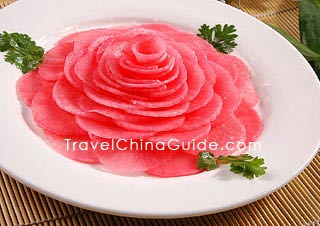
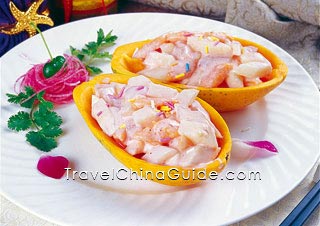
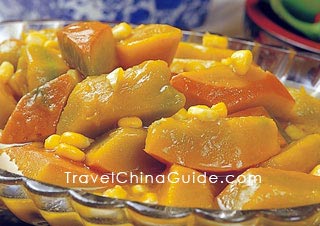
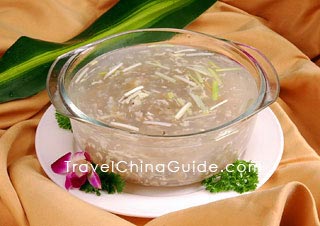





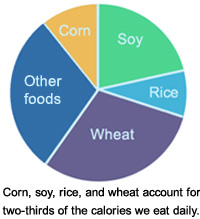 In addition, we are eating less variety of foods. Ironically, while 17,000 new products are introduced each year, two-thirds of our calories come from just four foods: corn, soy, wheat, and rice.
In addition, we are eating less variety of foods. Ironically, while 17,000 new products are introduced each year, two-thirds of our calories come from just four foods: corn, soy, wheat, and rice.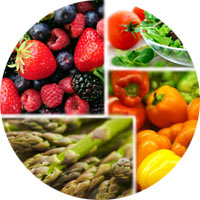 If you want to be more deliberate in improving health-perhaps to address a chronic disease or condition-you can read about an approach that is based on a Functional Medicineperspective. This perspective considers how various nutrients interact with the systems of the human body. See
If you want to be more deliberate in improving health-perhaps to address a chronic disease or condition-you can read about an approach that is based on a Functional Medicineperspective. This perspective considers how various nutrients interact with the systems of the human body. See 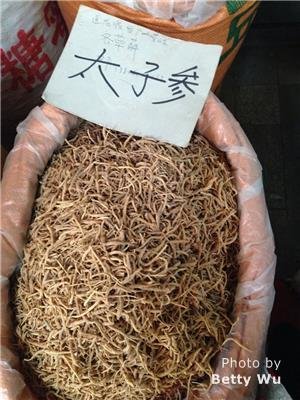 Traditional Chinese Herbs
Traditional Chinese Herbs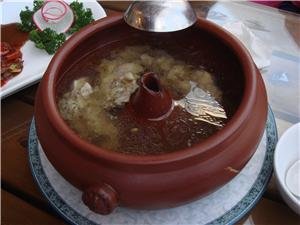 Chicken and Ginger Soup
Chicken and Ginger Soup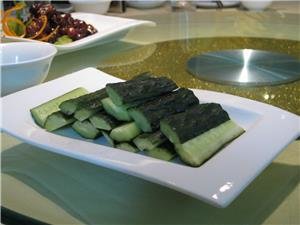 Cold Cucumber Salad
Cold Cucumber Salad
















